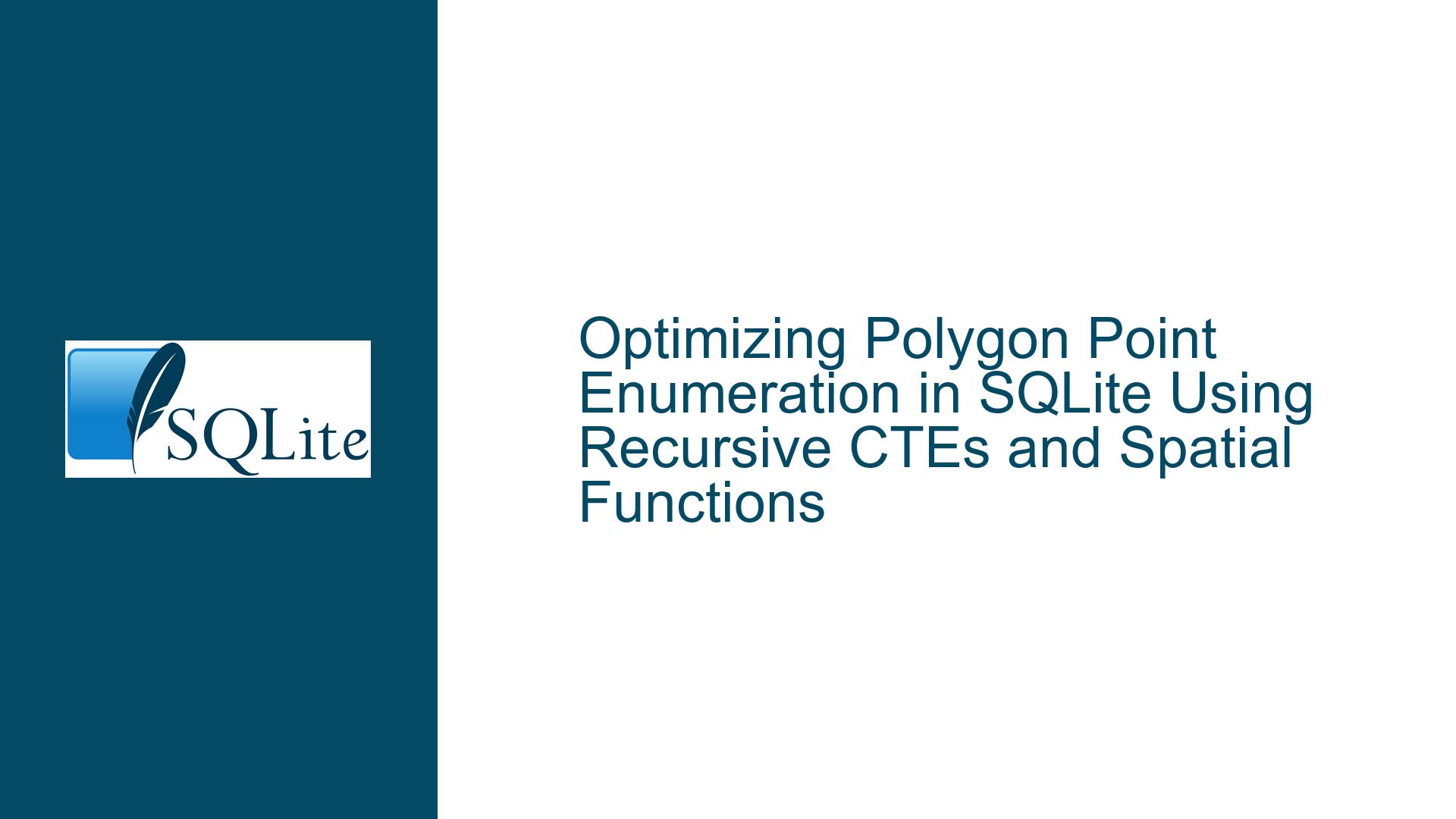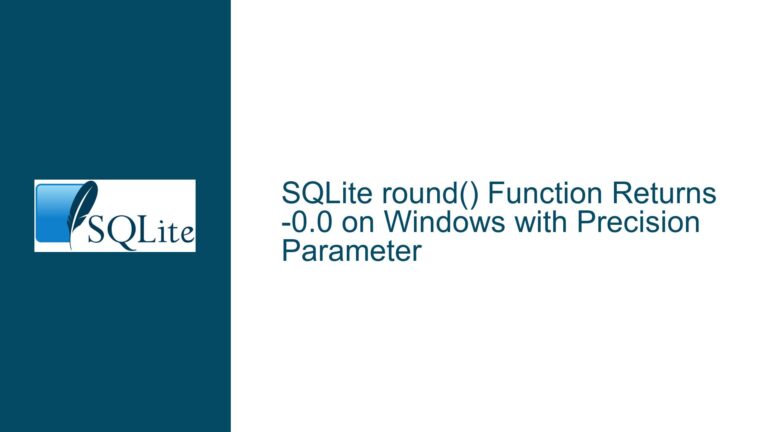Optimizing Polygon Point Enumeration in SQLite Using Recursive CTEs and Spatial Functions
Recursive CTE Performance Issues with Polygon Point Enumeration
When working with spatial data in SQLite, particularly polygons represented in Well-Known Text (WKT) or Well-Known Binary (WKB) formats, a common task is to enumerate the points that define the polygon’s boundary. This is often required for spatial analysis, visualization, or data transformation. SQLite, being a lightweight database, does not support session variables or explicit loops, which are commonly used in other databases for such tasks. Instead, developers must rely on recursive Common Table Expressions (CTEs) to achieve this functionality.
The core issue arises when attempting to enumerate the points of a polygon using a recursive CTE. The initial approach involves repeatedly embedding SELECT statements within the CTE to reference the polygon’s geometry. This method, while functional, raises concerns about performance, especially when dealing with large polygons or multiple rows in the dataset. The repeated SELECT statements can lead to inefficient query execution, as the database engine may re-evaluate the same subqueries multiple times, resulting in unnecessary computational overhead.
For example, consider a polygon with 255,955 points, such as the administrative boundary of Canada. Enumerating each point using a recursive CTE with embedded SELECTs can lead to significant performance degradation. The inefficiency stems from the fact that the polygon’s geometry is re-fetched and processed for each point, even though the geometry remains constant throughout the enumeration process. This redundancy can be particularly problematic in scenarios where the dataset contains multiple polygons, each with a large number of points.
Repeated Subquery Evaluation and Cartesian Joins
The primary cause of the performance issues in the recursive CTE approach is the repeated evaluation of subqueries within the CTE. Each recursive step involves re-fetching the polygon’s geometry and recalculating the coordinates of the next point. This results in redundant computations, as the polygon’s geometry does not change between recursive steps. The repeated subquery evaluation can lead to exponential growth in computational complexity, especially for polygons with a large number of points.
Another contributing factor is the use of Cartesian joins (cross joins) in some proposed solutions. A Cartesian join combines every row from one table with every row from another table, resulting in a potentially massive intermediate result set. While this approach can simplify the query logic by eliminating the need for explicit recursion, it can also lead to poor runtime performance, particularly when dealing with large datasets. For instance, if the tmp table contains multiple polygons, each with thousands of points, a Cartesian join between the tmp table and a table of point indices can result in an intermediate result set with millions of rows. This can overwhelm the database engine and lead to slow query execution.
Additionally, the lack of an explicit ON clause in some join operations can further exacerbate performance issues. Without an ON clause, the database engine may perform a full Cartesian join, even if the join condition is implicitly defined in the WHERE clause. This can lead to unnecessary data processing and increased memory usage, further degrading query performance.
Optimizing Recursive CTEs and Leveraging Spatialite Functions
To address the performance issues associated with recursive CTEs and polygon point enumeration, several optimization strategies can be employed. One effective approach is to minimize the repeated evaluation of subqueries by precomputing the polygon’s geometry and storing it in a temporary variable or table. This can be achieved by restructuring the recursive CTE to reference a precomputed geometry, rather than re-fetching it in each recursive step.
For example, instead of embedding SELECT statements within the CTE to fetch the polygon’s geometry, the geometry can be precomputed and stored in a temporary table. The recursive CTE can then reference this precomputed geometry, eliminating the need for repeated subquery evaluation. This approach can significantly reduce computational overhead and improve query performance, especially for large polygons.
Another optimization strategy is to leverage the ROWID of the table to avoid Cartesian joins. By using the ROWID as a join condition, the query can ensure that each polygon is matched with its corresponding point indices, without generating a massive intermediate result set. This approach can be particularly effective when dealing with multiple polygons, as it allows the query to process each polygon independently, without unnecessary data duplication.
For example, the following query demonstrates how to use the ROWID to optimize the recursive CTE:
WITH RECURSIVE pointNums (orig_rowid, n, max_n) AS (
SELECT rowid, 1, NumPoints(exteriorring(shape)) FROM tmp
UNION ALL
SELECT orig_rowid, n + 1, max_n
FROM tmp
WHERE n < max_n
)
SELECT
tmp.rowid,
tmp.Place,
n,
X(PointN(exteriorring(shape), n)) AS Longitude,
Y(PointN(exteriorring(shape), n)) AS Latitude
FROM
tmp INNER JOIN pointNums
ON pointNums.orig_rowid = tmp.rowid
ORDER BY rowid, n;
In this query, the ROWID is used to join the tmp table with the pointNums CTE, ensuring that each polygon is matched with its corresponding point indices. This eliminates the need for a Cartesian join and reduces the size of the intermediate result set, leading to improved query performance.
Finally, for users with access to the generate_series extension, an alternative approach is to use this function to generate the point indices, rather than relying on a recursive CTE. The generate_series function can efficiently generate a sequence of numbers, which can then be used to enumerate the points of the polygon. This approach can further simplify the query logic and improve performance, especially for large polygons.
For example, the following query demonstrates how to use the generate_series function to enumerate the points of a polygon:
SELECT
value,
X(PointN(exteriorring(shape), value)) AS Longitude,
Y(PointN(exteriorring(shape), value)) AS Latitude
FROM
tmp, generate_series(1, (SELECT NumPoints(exteriorring(shape)) FROM tmp), 1);
This query uses the generate_series function to generate a sequence of numbers from 1 to the number of points in the polygon. The value column is then used to fetch the coordinates of each point, eliminating the need for a recursive CTE. This approach can be particularly effective for users who have access to the generate_series extension and are dealing with large polygons.
In conclusion, optimizing polygon point enumeration in SQLite requires careful consideration of query structure and performance. By minimizing repeated subquery evaluation, avoiding Cartesian joins, and leveraging spatial functions such as generate_series, developers can significantly improve the efficiency of their queries. These strategies are particularly important when dealing with large polygons or multiple rows in the dataset, where performance issues are most likely to arise.






